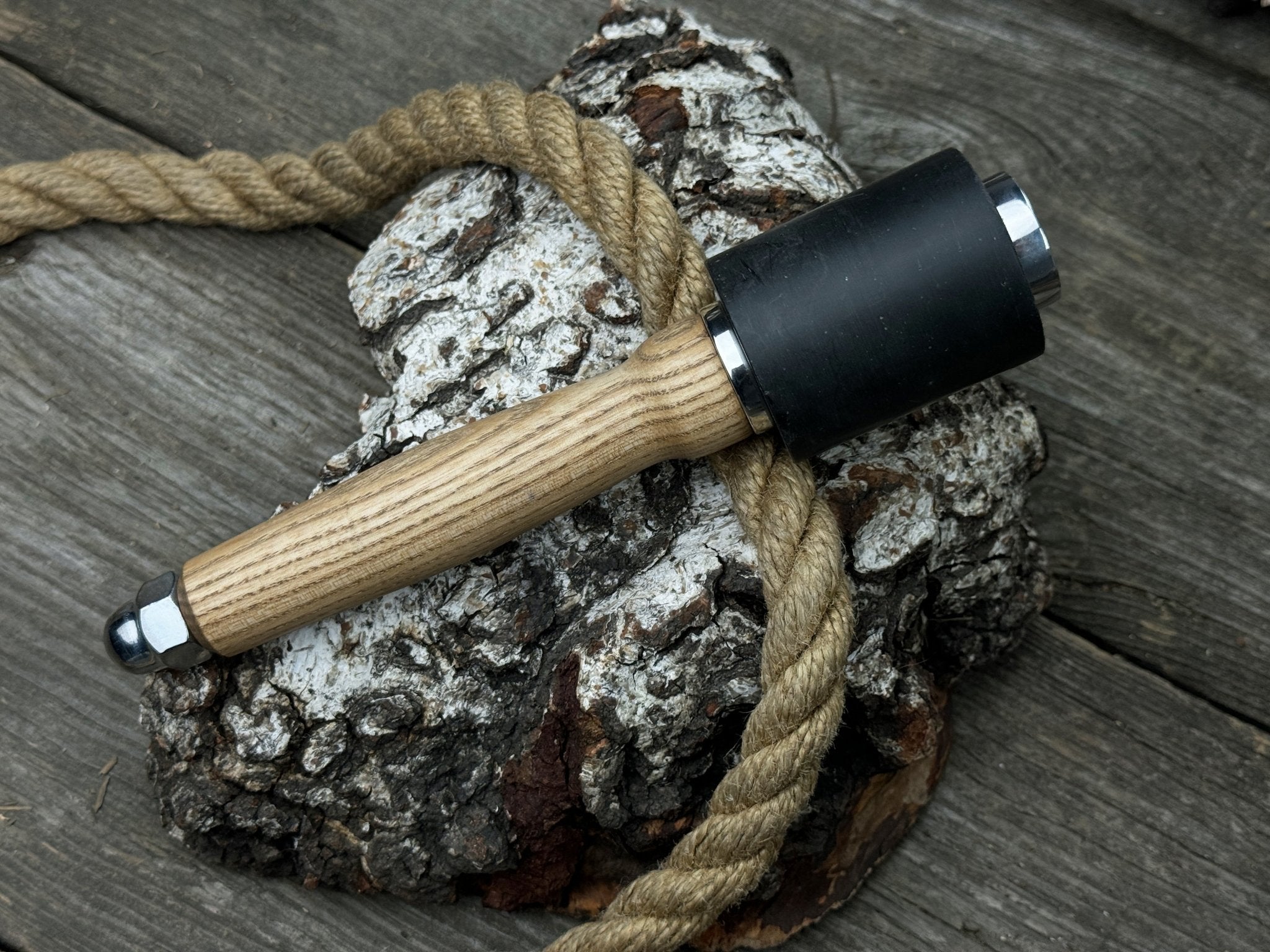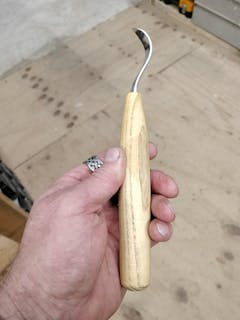Handgeschmiedeter Lederhammer, 500 g (17,6 oz)
Leiser 7-oz.-Holzhammer (Schlägelwerkzeug)
Leiser 35-oz-Holzhammer (Schlägelwerkzeug)
Leiser 23 oz Holzhammer (Schlägelwerkzeug)
Handgeschmiedeter Lederhammer, 500 g (17,6 oz)
Was sind Holzschlägel und warum sind sie unverzichtbar?
Definition und Hauptmerkmale
Holzhämmer werden häufig in der Zimmerei und Holzverarbeitung verwendet und sind handgeführte Werkzeuge, mit denen andere Werkzeuge wie Meißel angetrieben werden, Oberflächen ohne Beschädigungen zu schlagen oder Holzstücke zusammenzuschlagen. Generell ist ein Holzhämmer ideal für Aufgaben, die etwas Kraft und Präzision erfordern.
Holzhämmer bestehen aus einem Holzgriff, der zur besseren Kontrolle eng am Kopf anliegt, und einem tonnenförmigen Kopf. Die Köpfe eines Holzhämmers können aus verschiedenen Harthölzern (z. B. Ahorn, Weißeiche, Buche) und dichten Hölzern (z. B. Osage-Orange, Birke) gefertigt werden.
Der typische Aufbau eines Holzhammers ist wie folgt:
- Kopf: Ein gewöhnlicher Holzhammer wiegt etwa 2-4 Pfund. Der Kopf ist größer und weicher als der eines Hammers und für kontrolliertere und weichere Schläge ausgelegt.
- Griff: Normalerweise zwischen 10 und 16 Zoll lang, je nach Verwendungszweck des Hammers, mit einer Dicke von etwa 1 bis 1,5 Zoll, um einen stabilen Griff zu gewährleisten. Die meisten Griffe sind gerade, einige können sich jedoch zum Kopf hin leicht verjüngen, um einen sichereren Halt zu gewährleisten.
Anwendungen in der Holzbearbeitung
Holzhämmer bieten präzise Kontrolle und sanfte Wirkung, was sie zu unersetzlichen Helfern bei verschiedenen Arten von Holzbearbeitungsaufgaben macht:
- Meißeln und Schnitzen: Ein Holzhammer liefert die nötige Kraft zum Formen von Holz mit einem Meißel und ermöglicht kontrollierte, präzise Schnitte.
- Tischlerei: Ein Holzhammer hilft beim Herstellen von Holzverbindungen, wie Zapfenverbindungen, und sorgt für einen festen, sicheren Sitz, ohne das Holz zu spalten.
- Zusammenbau von Möbelstücken: Mit einem Holzhammer werden beim Zusammenbau von Möbeln Fugen und Bauteile an ihren Platz geklopft, ohne die Oberflächen zu beschädigen.
- Einstellen und Ausrichten: Diese Werkzeuge richten Holzstücke aus und passen sie an, indem sie kontrollierte Kraft anwenden, beispielsweise durch Klopfen auf die Schienen und Pfosten von Schranktüren.
- Eintreiben von Dübeln und Dübeln: Durch das Eintreiben von Dübeln und Dübeln in vorgebohrte Löcher wird sichergestellt, dass sie richtig sitzen, ohne das umliegende Holz zu beschädigen.
- Einstellen und Anpassen von Werkzeugen: Holzhämmer sind praktisch zum Einstellen und Anpassen von Werkzeugen wie Hobeleisen und Sägeblättern und helfen Holzarbeitern dabei, Teile mit einem Holzhammer an die richtige Stelle zu klopfen.
Wie sich Holzhämmer von Metall- und Gummihämmern unterscheiden
Jeder Hammertyp hat seine einzigartigen Stärken und wird auf der Grundlage der spezifischen Anforderungen der jeweiligen Aufgabe ausgewählt.
Während Holzhämmer besser für präzise Holzarbeiten geeignet sind, da sie Kontrolle und Stoßdämpfung bieten, sind Metallhämmer für schwere Arbeiten konzipiert, die mehr Haltbarkeit und Kraft erfordern. Gummihämmer hingegen bieten eine sanfte Berührung und minimieren die Beschädigung der umliegenden Oberflächen.
Schauen wir uns die Unterschiede zwischen diesen drei genauer an:
- Holzbearbeitungshammer: Dieser Holzbearbeitungshammer aus Hartholz bietet die kontrollierte Kraft, die für Aufgaben wie Meißeln und Zusammensetzen von Verbindungen erforderlich ist. Das Holz absorbiert Stöße, reduziert die Belastung des Benutzers und schützt das Werkstück. Bei starker Beanspruchung kann das Werkzeug jedoch mit der Zeit verschleißen.
- Metallhammer: Dieser Hammer besteht entweder vollständig aus Metall oder hat einen Metallkopf und einen Griff aus Holz oder Verbundwerkstoff. Er ist extrem langlebig und wird für Arbeiten mit hoher Schlagkraft wie das Einschlagen von Pfählen und die Metallbearbeitung verwendet. Obwohl er leistungsstark ist, kann er empfindliche Oberflächen und Werkzeuge leicht beschädigen.
- Gummihammer: Mit einem Gummikopf und einem Griff aus Holz, Metall oder Fiberglas ist dieser Hammer schonend zu Oberflächen und wird für Aufgaben wie das Anpassen von Fugen, das Zusammenbauen von Möbeln und das Verlegen von Fliesen verwendet. Er hat möglicherweise einen Rückpralleffekt und weniger Schlagkraft als ein Holzarbeiterhammer, kann aber auch über die Holzbearbeitung hinaus eingesetzt werden.
Arten von Holzschlägern: So wählen Sie den richtigen aus
Die Holzhammertypen unterscheiden sich im Design und passen sich den unterschiedlichen Anforderungen der Holzbearbeitung an. Verschiedene Harthölzer wie Eiche, Ahorn und Buche ermöglichen eine individuelle Anpassung von Gewicht und Balance für bestimmte Aufgaben. Zu den gängigen Typen gehören:
- Schnitz- und Meißelhämmer
Konstruktion: Ein Holzschnitzhammer hat oft einen zylindrischen Kopf und einen Griff aus Hartholz oder dichtem Holz.
Verwendung: Dieser Holzbearbeitungshammer wird für leichte Schläge beim Schnitzen und präzise Meißelschläge verwendet.
- Heavy-Duty-Schlägel für harte Schläge
Konstruktion: Ein schwerer Holzhammer mit großem, schwerem Kopf in rechteckiger Form; der Griff ist so konstruiert, dass er starker Beanspruchung standhält.
Verwendung: Der schwere Kopf ermöglicht kraftvolle Schläge zum Eintreiben großer Meißel, zum Zusammensetzen schwerer Verbindungen und für gelegentliche Abbrucharbeiten.
- Leichte Hämmer für Präzisionsarbeiten
Konstruktion: Diese Schlägel haben kleinere, leichtere Köpfe, die oft aus Weichhölzern wie Kiefer oder Birke hergestellt werden.
Verwendung: Feine Tischlerarbeiten, Anpassen kleiner Komponenten und Anbringen empfindlicher Oberflächen an der richtigen Stelle.
Wichtige Faktoren bei der Auswahl eines Holzhammers
Wenn Sie neu in der Holzbearbeitung sind, sollten Sie mit einem robusten, traditionellen Tischlerhammer aus Holz beginnen. Wenn Sie mit den verschiedenen Holzbearbeitungsaufgaben vertraut sind, können Sie spezielle Hämmer für die jeweilige Art der Arbeit hinzufügen. Durch Experimentieren mit Hammergewichten und -materialien können Sie die beste Wahl für Kontrolle und Wirkung finden.
Darauf sollten Sie bei dem Tool achten:
- Gewicht und Balance: Schwerere Schläger bieten mehr Kraft, während leichtere Schläger kontrollierte Bewegungen ermöglichen. Für sanftere Schläge sollte das Gewicht des Schlägers gleichmäßig zwischen Kopf und Griff verteilt sein.
- Griffdesign und Komfort: Ein bequemer, rutschfester Griff, der in Ihrer Hand liegt, ist unerlässlich. Wenn Sie einen Holzhammer für kräftige Schläge benötigen, wählen Sie das Werkzeug mit einem längeren Griff für eine bessere Hebelwirkung. Kürzere Griffe eignen sich besser für Projekte, bei denen Kontrolle und Präzision erforderlich sind.
- Holzart: Harthölzer wie Hickory und Ahorn sind dicht und robust für schwere Arbeiten, können aber mit der Zeit splittern. Weichere Hölzer wie Esche und Buche absorbieren Stöße besser und erzeugen einen sanfteren Aufprall. Wenn Sie einen Holzhammer zum Eintreiben eines Meißels verwenden, wird ein Hammer empfohlen, der weicher ist als der Meißelgriff.
Häufige Fehler, die bei der Verwendung von Holzschlägeln zu vermeiden sind
Ein häufiger Fehler ist die Auswahl des falschen Holzhammers für die jeweilige Aufgabe. Beispielsweise ist ein Hartholzhammer für die Holzbearbeitung effektiver als ein Gummihammer. Ein weiterer Fehler ist die Verwendung eines Hammers für schwere Aufgaben, für die Hämmer besser geeignet sind, wie das Einschlagen großer Nägel. Und hier sind noch ein paar weitere Fallstricke, die Sie vermeiden sollten:
- Übermäßige Schläge und ihre Folgen: Zu harte Schläge können den Kopf des Holzhammers spalten und das Werkstück beschädigen, insbesondere bei weicherem Holz. Übermäßige Schläge können auch zu Handgelenksverletzungen führen. Halten Sie den Griff für kräftige Schläge nahe der Basis und für mehr Kontrolle nahe dem Kopf. Verwenden Sie lange Schwünge für mehr Kraft und kurze, aus dem Handgelenk getriebene Schwünge für mehr Feingefühl.
Unsachgemäße Lagerung und Pflege: Die richtige Pflege verlängert die Lebensdauer eines Holzhammers. Reinigen Sie ihn regelmäßig mit einem feuchten Tuch, vermeiden Sie aggressive Chemikalien und lagern Sie ihn an einem kühlen, trockenen Ort, um temperaturbedingte Schäden zu vermeiden.














